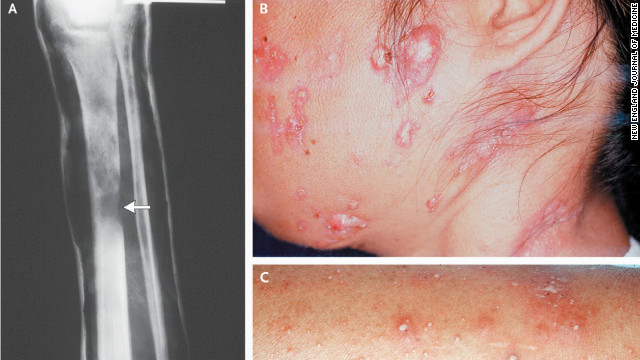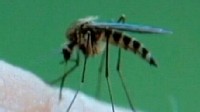Radiation
Fukushima fish carrying 258 times the ‘safe’ level of radiation

An official from Thailand’s Food and Drug Administration takes a sample from a shipment of frozen fish imported from Japan to test for possible radiation contamination at Ladkrabang customs in Bangkok (Reuters/Sukree Sukplang)
A pair of fish captured near Japan’s crippled Fukushima nuclear plant have shown to be carrying record levels of radiation. The pair of greenlings are contaminated with 258 times the level government deems safe for consumption.
The fish, which were captured just 12 miles from the nuclear plant, registered 25,800 becquerels of caesium per kilo, according to Tokyo Electric Power Company (TEPCO).
TEPCO says the high levels may be due to the fish feeding in radioactive hotspots. The company plans on capturing and testing more of the fish, as well as their feed, and the seabed soil to determine the exact cause of the high radiation.
The findings were surprising for officials, who had previously seen much lower levels of radiation in contaminated fish.
Fishermen been allowed to cast their reels in the nearby waters on an experimental basis since June – but only in areas more than 31 miles from the plant.
Previously, the highest recorded radiation seen in the captured wildlife was 18,700 becquerels per kilo in cherry salmons, according to the Japanese Fisheries Agency.
The radiation was caused by a meltdown of three reactors at the Fukushima power plant after it was damaged by an earthquake and tsunami in March 2011.
The disaster was so intense that contaminated fish were caught all the way across the Pacific Ocean, on the California coast.
But it’s not only aquatic life that is suffering from side effects of the leaked radiation.
According to researchers, the radiation has caused mutations in some butterflies, giving them dented eyes, malformed legs and antennae, and stunted wings.
The results show the butterflies were deteriorating both physically and genetically.
But the harmful risks don’t stop with butterflies. The radioactivity which seeped into the region’s air and water has left humans facing potentially life threatening health issues.
Over a third of Fukushima children are at risk of developing cancer, according to the Sixth Report of Fukushima Prefecture Health Management Survey.
The report shows that nearly 36 per cent of children in the Fukushima Prefecture have abnormal thyroid growths which pose a risk of becoming cancerous.
The World Health Organization warns that young people are particularly prone to radiation poisoning in the thyroid gland. Infants are most at risk because their cells divide at a higher rate.
************************************************************************************************************
Epidemic Hazards / Diseases
Bahamas reports 5 new cases amid bacteria outbreak
Perry Gomez says four adults and one child in the general intensive care unit of Princess Margaret Hospital in Nassau are carrying the bacteria.
About a month ago, the acinetobacter bamannii outbreak sickened eight babies in the neonatal intensive care unit, killing two.
Gomez announced in Parliament Thursday that the ministry will hire a physician to investigate the outbreak.
The hospital reported a similar outbreak in August 1996 that killed three infants and infected five others.
The bacteria enter the body through open wounds, breathing tubes and catheters and are highly resistant to antibiotics.
 The United Nations health agency today reported that the cholera outbreak in Sierra Leone was escalating and stressed the need to rapidly scale up the response to the spread of the of the frequently fatal water and food-borne disease.
The United Nations health agency today reported that the cholera outbreak in Sierra Leone was escalating and stressed the need to rapidly scale up the response to the spread of the of the frequently fatal water and food-borne disease.
In a press briefing in Geneva, Glenn Thomas, a spokesperson for the World Health Organization (WHO), confirmed the spread of cholera to an additional two districts of the West African country, noting that since the beginning of 2012, there had been 11,189 reported cases and 203 deaths due to the outbreak.
Mr. Thomas told reporters that the WHO was supporting the Government of Sierra Leone in the areas of epidemiology and social mobilization and had sent three cholera experts form its regional office to respond to the deteriorating crisis, UN News Service reports.
Cholera is an acute intestinal infection caused by eating food or drinking water contaminated with the bacterium known as vibrio cholerae. The disease has a short incubation period and produces a toxin that causes continuous watery diarrhoea, a condition that can quickly lead to severe dehydration and death if treatment is not administered promptly. Vomiting also occurs in most patients.
In his briefing, Mr. Thomas also provided an update on the outbreak of Ebola virus in the Democratic Republic of the Congo (DRC), where a total of 15 cases of viral contamination, including nine deaths, have been reported.
He said that the WHO was supporting the DRC Ministry of Health in conducting a series of epidemiological investigations as well as surveillance, public information and social mobilization initiatives.
Ebola is transmitted by direct contact with the blood, secretions, other bodily fluids or organs of infected persons or animals such as chimpanzees, gorillas, monkeys and antelopes, and it has an incubation period of two to 21 days.
Sufferers can experience fever, intense weakness, muscle pain, headaches and a sore throat, as well as vomiting, diarrhoea, rashes and impaired kidney and liver function. In the most severe cases, the virus leads to both external and internal bleeding. The most recent outbreak happened last month in Uganda with a total of 20 cases, including 14 deaths, reported across the western part of the country.
In its briefing, the WHO added that it did not recommend that any travel or trade restrictions be applied to the DRC because of the outbreak.
West Nile Is Spreading Farther and Faster This Season, CDC Says

Aerial mosquito spraying is underway in Dallas County and Houston to prevent the spread of West Nile virus while the disease spreads farther, faster and earlier in the season than ever before, according to the U.S. Centers for Disease Control and Prevention.
Only 29 cases were reported a month ago. Now, the CDC is reporting 1,118 cases spread across 47 states, with 41 deaths.
Seventy-five percent of the cases have been reported from five states: Texas, Mississippi, Louisiana, Oklahoma and Illinois. Texas appears to be the hardest hit, with 586 reported cases in total. The death toll in Texas was 21 as of Wednesday, with Dallas County hit hardest, for a total of 270 cases and 11 deaths.
No place is striking back harder against the West Nile virus than Texas, which has launched an aerial assault against mosquitoes despite objections from environmental groups. Overnight, planes carrying pesticides took to the skies dousing more than 63,000 acres of land in Dallas and Houston to battle the disease.
“These kinds of chemicals are most toxic to young children, infants and babies,” said Jennifer Sass, senior scientist at the Natural Resources Defense Council.
The CDC and health officials in Texas insist the worries about the spray are overblown and pale in comparison to the devastating effects of the disease. Harris County Mosquito Control Director Dr. Rudy Bueno told ABC News that the spray is “very safe and effective.”
“We normally kill 90, 95 percent of the mosquitoes that are out flying the night we put this out,” pilot Malcolm Williams said.
The CDC says this outbreak is on track to be the worst in the country’s history. The worst year on record is 2003, in which the country saw 9,862 cases of West Nile virus infection and 264 deaths.
Many experts point to last year’s mild winter for the drastic outbreak and the scorching temperatures this summer, helping the mosquitoes thrive.
Eighty percent of the people who contract the West Nile virus have no symptoms and their body eventually gets rid of it, according to the CDC. The remaining 20 percent experience flu-like symptoms.
One in 150 people will develop more severe forms of the disease and experience neurological symptoms and brain swelling, according to ABC News’ Dr. Richard Besser.
Patient Garrick Larson told ABC News affiliate WDAY in Minnesota, “I woke up with a headache like I have never come close to feeling before. The pain was immense. I knew I was in trouble.”
Larson, a cross country coach in Moorhead, Minn., was hospitalized for a week with a high fever and meningitis.
Deputy White House Press Secretary Josh Earnest briefed reporters aboard Air Force One as President Obama traveled from Las Vegas to New York Wednesday.
“The president’s been briefed on the increase in the number of West Nile virus cases,” he said. “[The] White House staff are at regular contact with the experts at the CDC, and the president will continue to receive updates as necessary.”
Researchers identify rare adult immune disease in Asia

- Patients with disease are making antibodies that attack their immune system
- Cases date back to 2004, with most of them occurring in Thailand and Taiwan
- Scientists do not believe the disease is contagious
- The NIH has seen about 12 cases, all in people of Asian descent
(CNN) — Researchers at the National Institutes of Health (NIH) have identified a new disease among people in Asia that causes AIDS-like symptoms but is not associated with HIV.
The study, released in the New England Journal of Medicine Thursday, found patients with the disease were making antibodies that attacked their immune systems.
“We all make molecules and proteins in the body that tell our immune system how to function properly,” said Dr. Sarah Browne, a clinical investigator at the National Institute of Allergy and Infectious Diseases at NIH and the lead author on the study.
“They tell different immune cells when to turn on and when to start fighting infection,” she said. “We found a large number of the patients that we studied with serious opportunistic infections make an antibody that blocks the function of one of these molecules, which is interferon-gamma.”
Without functioning interferon-gamma, people become more susceptible to certain types of infections — infections people with working immune systems normally don’t get, she said.
The disease is being called an adult-onset immunodeficiency syndrome because it strikes adults. Cases date back to 2004, with most of them occurring in Thailand and Taiwan. The NIH has been studying the disease since 2005.
“It’s rare — more prevalent over in Southeast Asia,” Browne told CNN. “But we have been diagnosing it here in the U.S. in individuals of Asian descent.”
So far NIH has seen about 12 cases, all of them in people of Asian descent. According to Browne, most patients survive. There have been deaths in other countries, she said, but did not know how many. No one has died in the United States.
Dr. Anthony Fauci, director of NIAID, says it’s important to note the disease is not contagious.
“It is not a virus, that’s the first thing. It’s not a new AIDS-like virus,” Fauci said. “It’s a syndrome that was noticed and discovered in Asia where people get opportunistic infections similar to HIV/AIDS, but the cause of the syndrome is not an infection like HIV.”
Fauci said researchers “found the people have an autoimmunity, where their bodies are making antibodies against a protein that’s important in fighting infection.
“The reason the body is making that antibody is unclear but it isn’t a virus like HIV that’s causing it,” he said. ” It’s autoimmune disease, and people get secondary infections similar to AIDS.”
The study was already in the early stages in 2009, when Kim Nguyen, a 62-year-old Vietnamese woman from Tennessee, came to NIH suffering from symptoms that would be linked to the mystery disease.
A little more than 200 people — almost exclusively from Thailand and Taiwan between the ages of 18 and 78 — were studied. All were HIV-negative.
“We want to understand what triggers people to make these antibodies in the first place,” Browne said. “And we want to use that information to guide treatment — because really, when you treat the infection you’re treating the symptom. You’re not treating the underlying cause.”
Right now, doctors are simply treating the infections. For many of the patients, that’s sufficient, Browne said, but for those cases where it’s not, they are trying to find ways to target the antibodies themselves by lowering the antibody levels and trying to reverse the immunodeficiency.
Both Fauci and Browne believe a combination of both genetic and environmental factors are most likely at play, but don’t yet know what those factors are.
“Overall it appears to be a chronic disease, but we have not yet studied it for a long enough period of time to know the long-term prognosis,” Browne said. “We don’t yet know what factors may distinguish those with mild versus those with severe disease.”
| 19.08.2012 | Epidemic Hazard | Democratic Republic of the Congo | Province of Orientale, [Haut Uele District] |
Epidemic Hazard in Democratic Republic of the Congo on Friday, 17 August, 2012 at 03:03 (03:03 AM) UTC.
| Updated: | Wednesday, 22 August, 2012 at 03:06 UTC |
| Description | |
| The Ebola virus has killed 10 people in the Democratic Republic of Congo, the World Health Organization said Tuesday. As of Monday, WHO said, the deaths are among 13 probable and two confirmed Ebola cases reported in Orientale province in eastern Congo. The Congolese Ministry of Health has set up a task force to deal with the outbreak and is working with WHO, UNICEF, Doctors Without Borders and the Centers for Disease Control and Prevention. Twelve cases and eight deaths occurred in the area of Isiro, a town in Congo’s north, WHO said. The fatalities included three health care workers. One death each occurred in Congo’s Pawa and Dungu regions. Congo’s Orientale province borders western Uganda, where 24 probable and confirmed cases, including 16 deaths, have been reported since the beginning of July.But WHO spokesman Gregory Hartl told CNN that there’s no connection between the outbreaks in Uganda and Congo. The viruses, he said, are two different Ebola strains. There are five strains of the virus, a highly infectious and often fatal agent spread through direct contact with bodily fluids And, Hartl said, it is extremely difficult to travel between Isiro, for example, and Kiballe, the western Ugandan district where an outbreak emerged last month. That’s because it is heavily forested with impassable roads, and the only viable way to travel is going 10 to 15 kilometers per hour via motorbike. So it is unlikely there would be contact between Ugandans and Congolese that would lead to infection. The natural habitat of the Ebola virus is in the central African forest belt region, Hartl said. It’s “either by chance” or from “more surveying” for the disease, he said, that “we see these two outbreaks concurrently.” Health agencies have embarked on an aggressive approach in Uganda to deal with the cases. WHO has asked countries bordering Uganda to “enhance surveillance” for the virus. The last confirmed case in Uganda was admitted to an isolation facility on August 4, WHO said. | |




Comments